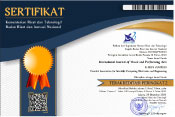(2) Agus Prijono
(3) Ariesa Pandanwangi
*corresponding author
AbstractUsing the Turtle Graphic algorithm to digitize and develop Sumatra batik motifs is an innovative step in preserving local wisdom. This algorithm, which was originally used in graphics programming to educate children about computer concepts, is now being utilized to design and reproduce intricate and detailed batik motifs. The problem is that most existing batik motifs have not been digitally stored. Therefore, the purpose of the research here is to digitize Sumatra batik motifs using the Turtle Graphics algorithm. Turtle graphics utilizes command-based programming principles to draw geometric shapes. As an icon for North Sumatra Province, the basic motif of the existing water tower batik is the focus of this pattern accuracy. It is documented using a Python program that uses the turtle graphics algorithm, and a new Sumatran batik motif design is created from this basic motif. The benefits of research results with this approach are that designers can digitally modify and reproduce traditional batik motifs. This algorithm allows the drawing of patterns with high accuracy, making creating consistent and precise motifs easier. This digitization process also helps document and preserve batik motifs. The use of this technology not only speeds up the design process but also provides wider access to the younger generation and the international community to appreciate and learn about Sumatra batik. By integrating modern technology and local wisdom, the digitization of rare batik motifs has the potential to strengthen cultural identity and increase the economic value of traditional batik products. The specific steps in the motif digitization or pattern-making process are as follows: determine the motif to be digitized, select the starting point of the moving turtle, determine the turtle's direction of motion in relation to the curve to be formed, execute the program, and if the turtle curve does not move in the desired direction, change the program and execute again until the turtle motion curve matches the desired curve. This process is repeated multiple times. KeywordsSumatra Batik; Motif design; Digitalization Motifs Program; Turtle Graphics; Local wisdom
|
DOIhttps://doi.org/10.31763/viperarts.v6i2.1633 |
Article metrics10.31763/viperarts.v6i2.1633 Abstract views : 199 | PDF views : 23 |
Cite |
Full Text Download Download
|
References
[1] M. S. Gazzaniga, The split brain revisited. 2000. doi: 10.1038/scientificamerican0798-50, doi : 10.1038/scientificamerican0798-50.
[2] S. Pinker, “The Language Instinct.†Dutton, 2007.
[3] S. Pinker, How the mind works. London: Penguin Books, 1997.
[4] A. R. Luria, The Working Brain : An Introduction To Neuropsychology. Basic Books, 1973.
[5] R. E. Jung and R. J. Haier, “The Parieto-Frontal Integration Theory (P-FIT) of intelligence: Converging neuroimaging evidence,†Behav. Brain Sci., vol. 30, no. 2, pp. 135–154, 2007, doi: 10.1017/S0140525X07001185.
[6] S. Beilock, Choke: What the Secrets of the Brain Reveal About Getting It Right When You Have To. 2010. doi: 10.1080/21520704.2011.564535.
[7] V. S. Ramachandran and S. Blakeslee, Phantoms in the Brain, Probing the Mysteries of the Human Mind. 1998.
[8] H. Gardner, Frames of Mind: The Theory of Multiple Intelligences. Basic Books, 1993.
[9] R. W. Sperry, “Cerebral organization and behavior,†Science, vol. 133, no. 3466. pp. 1749–1757, 1961. doi: 10.1126/science.133.3466.1749.
[10] M. Chirimuuta, The Brain Abstracted, no. December. 2024. doi: 10.7551/mitpress/13804.001.0001.
[11] M. S. Gazzaniga, “The Ethical Brain,†J. R. Soc. Med., vol. 98, no. 9, pp. 433–434, 2005, doi: 10.1258/jrsm.98.9.433.
[12] D. J. Levitin, This is your brain on music, First edit. 2006.
[13] R. Ratnadewi, A. Pandanwangi, and A. Prijono, “Learning mathematics through art in a faculty of engineering,†World Trans. Eng. Technol. Educ., vol. 19, no. 3, pp. 271–275, 2021.
[14] 3DTotal Publishing, Digital Art Masters, no. Volume 8. 3DTotal Publishing, 2013.
[15] A. S. M. Sayem, Digital Fashion Innovations : Advances in Design , Simulation , and Industry, no. April. Textile Institute Professional Publications Series, 2023. doi: 10.1201/9781003264958.
[16] J. McCarthy and P. Wright, Technology as experience, vol. 11, no. 5. 2004. doi: 10.1145/1015530.1015549.
[17] C. Paul, “Review of Christiane Paul ’ s 2003 ’ Digital Art ’ Thames & Hudson,†Digit. Art, vol. 224, no. January 2004, 2003.
[18] H. Yeung, T. Choi, and C. Chiu, Innovative Quick Response Programs in Logistics and Supply Chain Management, no. July. 2010. doi: 10.1007/978-3-642-04313-0.
[19] P. Elance, “Turtle graphics using Python,†Tutorial points, 2019.
[20] J. Zelle, Python programming: an introduction to computer science. Franklin, Beedle & Associates Inc, 2010.
[21] W. Wibawanto, T. Triyanto, A. Cahyono, and T. R. Rohendi, “Teaching the Creation of Batik Motifs to Foreign Students through Distance Learning,†Int. J. High. Educ., vol. 10, no. 7, p. 1, 2021, doi: 10.5430/ijhe.v10n7p1.
[22] R. Dinata and Z. Fan, “Elaboration of Batik Pattern Design Application in Indonesia,†Int. Humanit. Appl. Sci. J., vol. 2, no. 3, pp. 50–57, 2019, doi: 10.22441/ihasj.2019.v2i2.06.
[23] R. Goldman, S. Schaefer, and T. Ju, “Turtle Geometry in Computer Graphics and Computer Aided Design,†J. Chem. Inf. Model., vol. 53, no. 9, pp. 1689–1699, 2013.
[24] R. Ratnadewi, A. Pandanwangi, and A. Prijono, Implementasi bahasa Python pada motif batik Tasikmalaya, Cetakan Pe. Bandung: Penerbit Yayasan Lembaga Gumun Indonesia viii, 2021.
[25] F. Nisa, “Batik Sumatera Utara , 20 + Motif Khas Batak dan Melayu beserta Maknanya,†2023.
[26] G.A.Agoston, Color Theory and Its Application in Art and Design, vol. 11, no. 1. Springer, 1970.
[27] R. Ratnadewi, “Batik Sumatera Utara Motif Lereng Menara Air,†EC00202476802, 2024
[28] S. Cele, M. Stewart, and R. Asiedu, “Digital Archival Preservation and Cultural Heritage,†J. Digit. Humanit. Assoc. South. Africa, vol. 5, no. 1, 2024, doi: 10.55492/dhasa.v5i1.5017.
[29] J.-A. Beraldin et al., “Virtual Reconstruction of Heritage Sites: Opportunities and Challenges Created by 3D Technologies,†Int. Work. Rec. Model. Vis. Cult. Heritage., no. January, 2005.
Refbacks
- There are currently no refbacks.
Copyright (c) 2024 Ratnadewi Ratnadewi, Agus Prijono, Ariesa Pandanwangi

This work is licensed under a Creative Commons Attribution-ShareAlike 4.0 International License.
___________________________________________________________
International Journal of Visual and Performing Arts
ISSN 2684-9259
Published by Association for Scientific Computing Electronics and Engineering (ASCEE)
W: http://pubs2.ascee.org/index.php/viperarts
E: sularso@ascee.org
Organized by:
 This work is licensed under a Creative Commons Attribution-ShareAlike 4.0
This work is licensed under a Creative Commons Attribution-ShareAlike 4.0
























